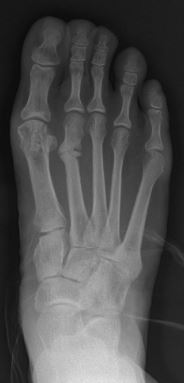
Back كسر الإجهاد Arabic Knochenbruch#Ermüdungsfraktur German Fractura por fatiga Spanish شکستگی تنشی استخوان Persian Rasitusmurtuma Finnish Fracture de fatigue French שבר מאמץ HE 疲労骨折 Japanese 피로골절 Korean Stressfractuur Dutch
| Stress fracture | |
|---|---|
| Other names | Hairline fracture, fissure fracture, march fracture, spontaneous fracture, fatigue fracture |
 | |
| Stress fracture of the second metatarsal bone (below the knuckles of the second toe) | |
| Specialty | Orthopedics |
A stress fracture is a fatigue-induced bone fracture caused by repeated stress over time. Instead of resulting from a single severe impact, stress fractures are the result of accumulated injury from repeated submaximal loading, such as running or jumping. Because of this mechanism, stress fractures are common overuse injuries in athletes.[1]
Stress fractures can be described as small cracks in the bone, or hairline fractures. Stress fractures of the foot are sometimes called "march fractures" because of the injury's prevalence among heavily marching soldiers.[2] Stress fractures most frequently occur in weight-bearing bones of the lower extremities, such as the tibia and fibula (bones of the lower leg), metatarsal and navicular bones (bones of the foot). Less common are stress fractures to the femur, pelvis, and sacrum. Treatment usually consists of rest followed by a gradual return to exercise over a period of months.[1]
- ^ a b Behrens, Steve; Deren, Matson; Fadale, Monchik (March–April 2013). "Stress Fractures of the Pelvis and Legs in Athletes: A Review". Sports Health: A Multidisciplinary Approach. 5 (2): 165–174. doi:10.1177/1941738112467423. PMC 3658382. PMID 24427386.
- ^ Payne, Jacqueline (26 March 2018). "Metatarsal Fractures". Patient.info. Retrieved 30 November 2020.
© MMXXIII Rich X Search. We shall prevail. All rights reserved. Rich X Search